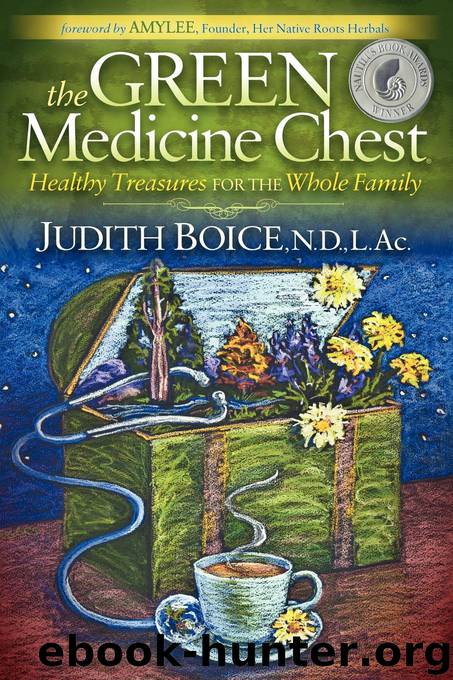The Green Medicine Chest by Judith Boice

Author:Judith Boice
Language: eng
Format: epub
Published: 2019-04-02T16:00:00+00:00
HOMEOPATHIC REMEDIES
Modern homeopathic medicine is based on the rediscovery of an ancient principle, using like to treat like. Developed by Dr. Samuel Hahnemann, a late 18 th century physician, this form of medicine aims to stimulate the body’s innate healing capacity to bring about a “cure.” The science of homeopathy grew out of Hahnemann’s years of medical-text translations. Discouraged by the medical practices of his day, Hahnemann abandoned his medical practice and translated medical texts to support his large family. He also hoped to discover universal laws of healing that were more effective than the conventional medicine of his day, which relied on bleeding, blistering, herbs, sulfur and petroleum for its cures.
While translating Cullen’s Material Medica, Hahnemann noted Cullen’s explanation for why quinine effectively treated malaria. The author hypothesized that quinine treated malaria because of its astringent properties. To test this idea, Hahnemann took four drams (one-half ounce), or about 15 doses, of quinine every morning and evening. Within four days he developed the symptoms of malaria in his formerly healthy body. When Hahnemann stopped taking the quinine, the malaria symptoms resolved.
With this experiment, Hahnemann confirmed “the Law of Similars,” using like to treat like. In other words, a substance that produced symptoms in a healthy person can be used in dilute form to treat the same symptoms in an ailing person.
Hahnemann and his students tested many substances to discover their effects on a healthy person. They would take careful notes about all of the changes that the remedy would produce, e.g., new physical symptoms, food cravings, sleep position, mood changes, sleep patterns, etc. Each person would take careful notes about the changes he or she experienced. These individual notes would be compiled to create a composite picture of the effects of the remedy. If a symptom or physical change commonly occurred, this symptom was called a “keynote” for the remedy. These research studies of particular substances are called “provings,” e.g., proving the effect of a substance on a healthy body.
During his years of research, Hahnemann discovered another basic truth: The more dilute the medicine, the more potent its effect. His discovery ran contrary to the practices of his day, an era when doctors prescribed large doses of mercury, sulfur, coal oil and other toxic substances to produce violent, cathartic effects in the body.
A patient recently reported that a national news program had conducted an exposé on homeopathic medicine. “The reporters discovered there wasn’t anything in the remedies!” said the patient, certain that he had debunked any possible claims about homeopathy’s effectiveness.
“The reporter was absolutely correct,” I replied, smiling patiently. “Beyond a 12c potency of a remedy, there is no physical matter in the remedy. What the reporter didn’t talk about, though, was that research in Germany shows that whatever substance was used to prepare the remedy is imprinted in the molecular structure of the water, and that imprint grows stronger with each dilution.”
The patient looked mystified. We talked about water’s ability to imprint anything it comes in contact with.
Download
This site does not store any files on its server. We only index and link to content provided by other sites. Please contact the content providers to delete copyright contents if any and email us, we'll remove relevant links or contents immediately.
| Acupuncture & Acupressure | Aromatherapy |
| Ayurveda | Chelation |
| Chinese Medicine | Energy Healing |
| Healing | Herbal Remedies |
| Holistic | Homeopathy |
| Hypnotherapy | Massage |
| Meditation | Naturopathy |
| Reference |
Inner Engineering: A Yogi's Guide to Joy by Sadhguru(6752)
The Power of Now: A Guide to Spiritual Enlightenment by Eckhart Tolle(5674)
Fear by Osho(4695)
Ikigai by Héctor García & Francesc Miralles(4170)
The Art of Happiness by The Dalai Lama(4089)
The Ultimate Bodybuilding Cookbook by Kendall Lou Schmidt(3906)
Yoga Therapy by Mark Stephens(3721)
The Little Book of Hygge by Meik Wiking(3659)
The Healing Self by Deepak Chopra(3522)
Why Buddhism is True by Robert Wright(3423)
The Hatha Yoga Pradipika (Translated) by Svatmarama(3280)
Being Aware of Being Aware by Rupert Spira(3246)
Shift into Freedom by Loch Kelly(3162)
Wild Words from Wild Women by Stephens Autumn(3114)
Work Clean by Dan Charnas(3077)
Happiness by Matthieu Ricard(3017)
More Language of Letting Go: 366 New Daily Meditations by Melody Beattie(2998)
Yoga Body & Mind Handbook by Jasmine Tarkeshi(2849)
Why I Am Not a Feminist by Jessa Crispin(2720)
